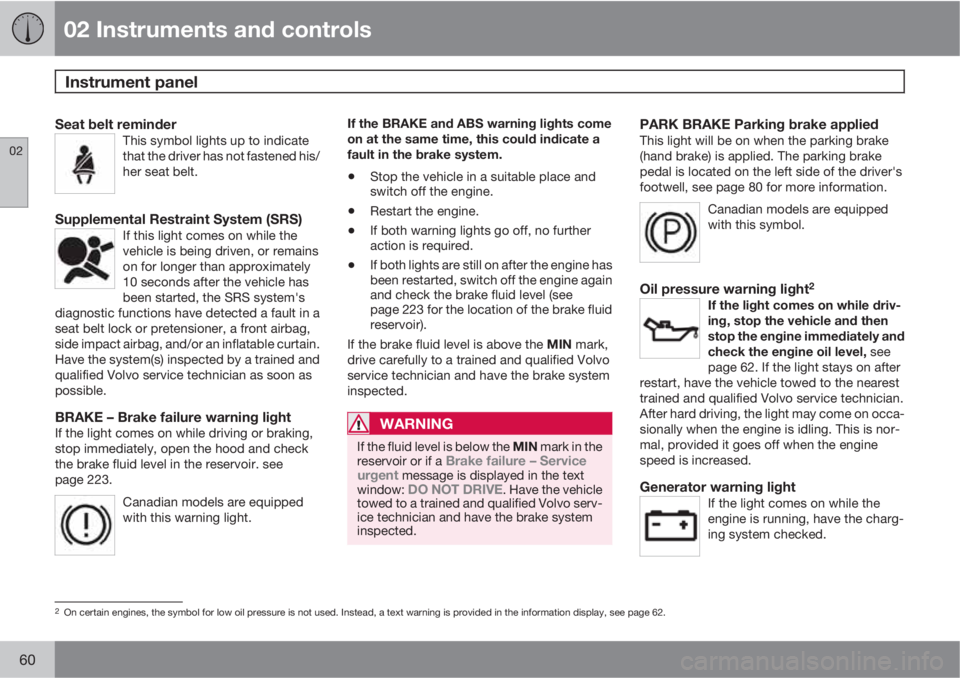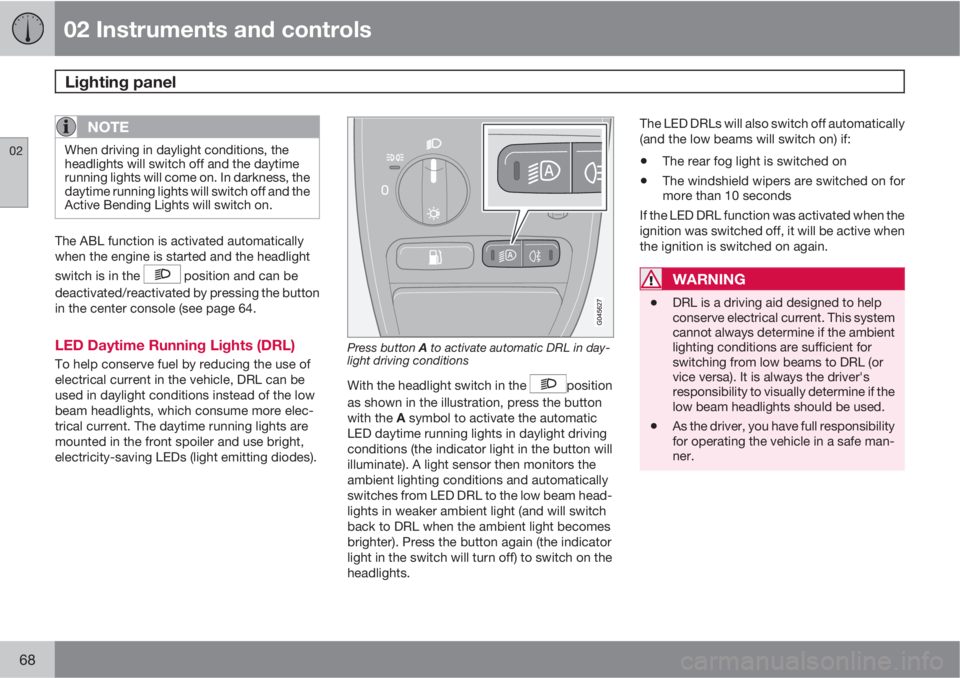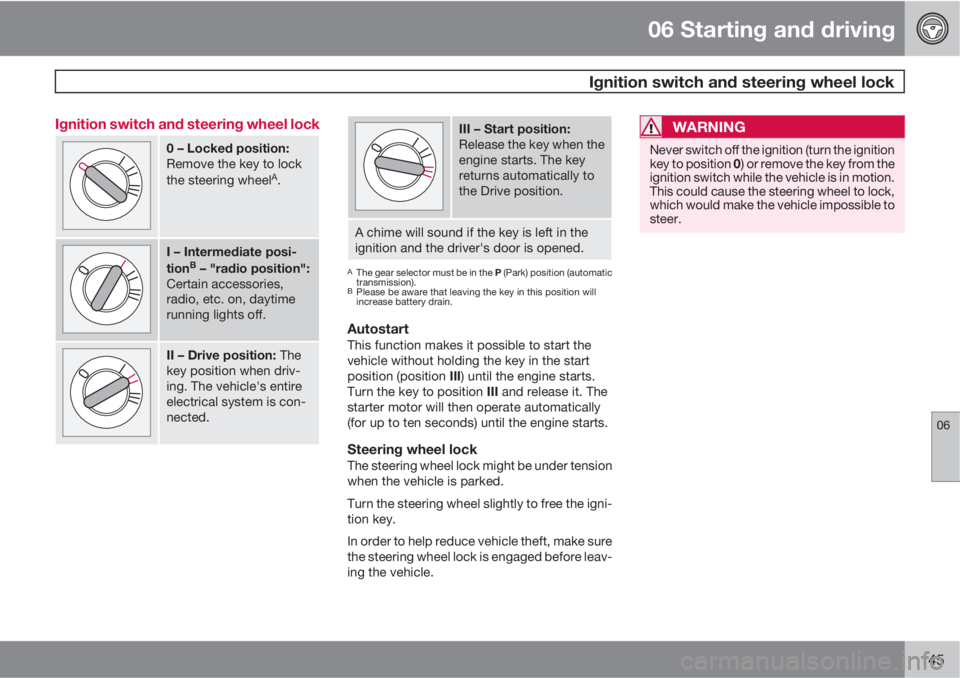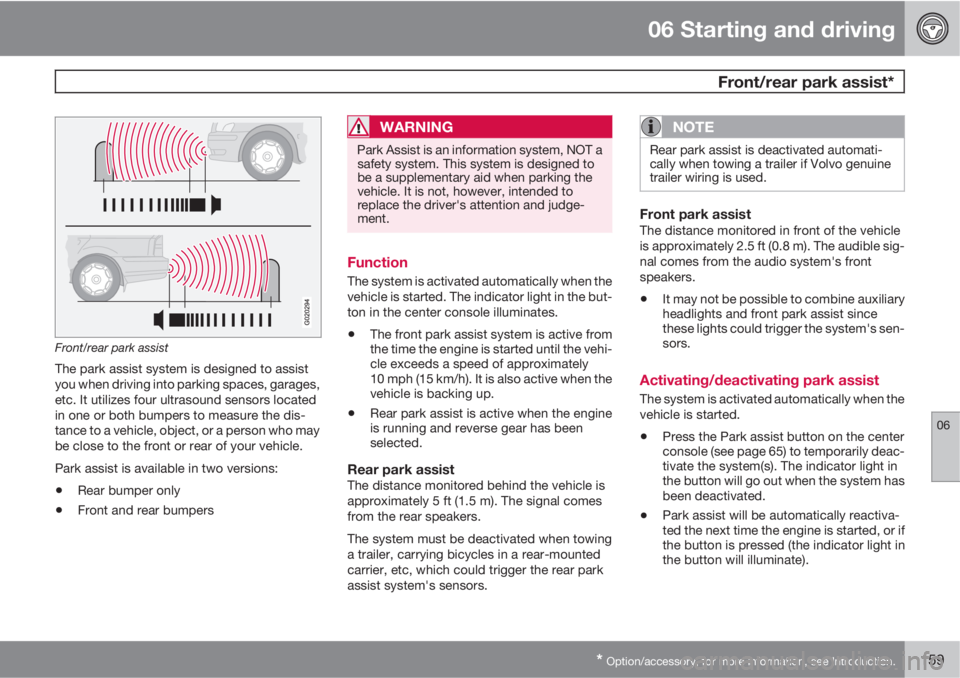warning lights VOLVO XC90 2013 Owner´s Manual
[x] Cancel search | Manufacturer: VOLVO, Model Year: 2013, Model line: XC90, Model: VOLVO XC90 2013Pages: 310, PDF Size: 8.62 MB
Page 31 of 310

01 Safety
Occupant Weight Sensor01
29
WARNING
•If a fault in the system is detected and
indicated as explained, be aware that
the passenger's side front airbag will
not deploy in the event of a collision.
•In this case, the safety systems and
Occupant Weight Sensor should be
inspected by a trained and qualified
Volvo service technician as soon as
possible.
WARNING
•Never try to open, remove, or repair any
components in the OWS system. This
could result in system malfunction.
Maintenance or repairs should only be
carried out by a trained and qualified
Volvo service technician.
•The front passenger's seat should not
be modified in any way. This could
reduce pressure on the seat cushion,
which might interfere with the OWS sys-
tem's function.
The OWS is designed to disable (will not inflate)
the passenger's side front airbag when a rear
facing infant seat, a forward-facing child
restraint, or a booster seat is detected. The
PASSENGER AIRBAG OFF indicator lamp willilluminate and stay on to remind you that the
passenger's side front airbag is disabled (see
the following table).
Passeng-
er's seat
occu-
pancy sta-
tusOWS indi-
cator light
statusPasseng-
er's side
front air-
bag status
Seat unoc-
cupiedOWS indica-
tor light
is not
lit
Passenger's
side front
airbag disa-
bled
Seat occu-
pied by low
weight
occupant/
object
A
OWS indica-
tor light
lights
up
Passenger's
side front
airbag disa-
bled
Seat occu-
pied by
heavy occu-
pant/objectOWS indica-
tor light
is not
lit
Passenger's
side front
airbag ena-
bled
AVolvo recommends that children always be properly
restrained in appropriate child restraints in the rear seats.In
rare situations when the seat belt is not properly fastened,
some child restraints may not be detected by the OWS
because there is very little weight on the vehicle seat cush-
ion. In these cases the passenger's side front airbag may be
disabled, but the PASSENGER AIRBAG OFF indicator lamp
will not be lit. Do not assume that the passenger's side front
airbag is disabled unless the PASSENGER AIRBAG OFFindicator lamp is lit. Make sure the child restraint is properly
installed (turn the vehicle off, remove the child restraint from
the vehicle and reinstall the restraint following the child
restraint manufacturer's instructions) and that the
PASSENGER AIRBAG OFF indicator lamp is on, or move
the child restraint to the rear seat.
The OWS is designed to enable (may inflate)
the passenger's side front airbag in the event
of a collision anytime the system senses that a
person of adult size is sitting properly in the
front passenger's seat. The PASSENGER
AIRBAG OFF indicator lamp will be off and
remain off.
If a person of adult size is sitting in the front
passenger's seat, but the PASSENGER
AIRBAG OFF indicator lamp is on, it is possible
that the person isn't sitting properly in the seat.
If this happens:
1. Turn the vehicle off and ask the person to
place the seat back in an upright position.
2. Have the person sit upright in the seat,
centered on the seat cushion, with the per-
son's legs comfortably extended.
3. Restart the vehicle and have the person
remain in this position for about two
minutes. This will allow the system to
detect that person and enable the pas-
senger's frontal airbag.
4.
If the PASSENGER AIRBAG OFF indicator
lamp remains on even after this, the person
should be advised to ride in the rear seat.
Page 59 of 310

02 Instruments and controls
Instrument overview
02
* Option/accessory, for more information, see Introduction.57
Headlights/Parking lights
Panel vents
Display
Temperature gauge
Odometer/Trip odometer/Cruise control
indicator
Speedometer
Turn signal indicator lights
Tachometer
Ambient temperature gauge, clock, gear
indicator
Fuel gauge
Indicator and warning symbols
Panel vents
Glove compartment
Hazard warning flashers
Audio system
Climate system controls
Windshield wiper/washer lever
Audio control buttons in steering wheel
Instrument panel
Horn
Cruise control buttons in steering wheel
Turn signals, High/low beams, READ-but-
ton
Parking brake pedal
Parking brake release handle
Reading lights
Courtesy light
Moonroof control*
Seat belt reminder
Rearview mirror
Control panel in the driver's door
G029570
Central locking button
Lockout switch for rear seat power win-
dows
Power window controls
Door mirror controls
Page 62 of 310

02 Instruments and controls
Instrument panel
02
60
Seat belt reminderThis symbol lights up to indicate
that the driver has not fastened his/
her seat belt.
Supplemental Restraint System (SRS)If this light comes on while the
vehicle is being driven, or remains
on for longer than approximately
10 seconds after the vehicle has
been started, the SRS system's
diagnostic functions have detected a fault in a
seat belt lock or pretensioner, a front airbag,
side impact airbag, and/or an inflatable curtain.
Have the system(s) inspected by a trained and
qualified Volvo service technician as soon as
possible.
BRAKE – Brake failure warning lightIf the light comes on while driving or braking,
stop immediately, open the hood and check
the brake fluid level in the reservoir. see
page 223.
Canadian models are equipped
with this warning light.
If the BRAKE and ABS warning lights come
on at the same time, this could indicate a
fault in the brake system.
•Stop the vehicle in a suitable place and
switch off the engine.
•Restart the engine.
•If both warning lights go off, no further
action is required.
•If both lights are still on after the engine has
been restarted, switch off the engine again
and check the brake fluid level (see
page 223 for the location of the brake fluid
reservoir).
If the brake fluid level is above the MIN mark,
drive carefully to a trained and qualified Volvo
service technician and have the brake system
inspected.
WARNING
If the fluid level is below the MIN mark in the
reservoir or if a Brake failure – Service
urgent message is displayed in the text
window: DO NOT DRIVE. Have the vehicle
towed to a trained and qualified Volvo serv-
ice technician and have the brake system
inspected.
PARK BRAKE Parking brake appliedThis light will be on when the parking brake
(hand brake) is applied. The parking brake
pedal is located on the left side of the driver's
footwell, see page 80 for more information.
Canadian models are equipped
with this symbol.
Oil pressure warning light2
If the light comes on while driv-
ing, stop the vehicle and then
stop the engine immediately and
check the engine oil level, see
page 62. If the light stays on after
restart, have the vehicle towed to the nearest
trained and qualified Volvo service technician.
After hard driving, the light may come on occa-
sionally when the engine is idling. This is nor-
mal, provided it goes off when the engine
speed is increased.
Generator warning lightIf the light comes on while the
engine is running, have the charg-
ing system checked.
2On certain engines, the symbol for low oil pressure is not used. Instead, a text warning is provided in the information display, see page 62.
Page 63 of 310

02 Instruments and controls
Instrument panel
02
61
Rear fog lightThis light indicates that the fog
light is on.
CHECK ENGINE Malfunction indicator
light
On-Board Diagnostics II (OBDII): As you drive,
a computer called "OBDII" monitors your vehi-
cle's engine, transmission, electrical and emis-
sion systems. The CHECK ENGINE light will
light up if the computer senses a condition that
potentially may need correcting. When this
happens, please have your vehicle checked by
a trained and qualified Volvo service technician
as soon as possible.
A CHECK ENGINE light may have many cau-
ses. Sometimes, you may not notice a change
in your vehicle's behavior. Even so, an uncor-
rected condition could hurt fuel economy,
emission cleanliness, and driveability.
Extended driving without correcting the cause
could even damage other components in your
vehicle.
Canadian models are equipped
with this symbol for the Malfunc-
tion Indicator Light.
ABS (Anti-lock brake system)If the warning light comes on, there
is a malfunction of the ABS system
(the standard braking system will
still function). The vehicle should
be driven to a trained and qualified
Volvo service technician for inspection. See
page 153 for additional information.
DSTC systemThe Dynamic Stability and Traction
Control system (DSTC) is
explained in greater detail on page
157.
Tire pressure monitoring lightSee page 200 for more informa-
tion on this function.
Turn signal indicator – trailer (certain
models)
If you are towing a trailer, this light
will flash simultaneously with the
turn signals on the trailer. If the
light does not flash when signaling,
neither the trailer's turn signals nor
the vehicle's turn signals are functioning.
Page 67 of 310

02 Instruments and controls
Center console buttons
02
* Option/accessory, for more information, see Introduction.65
NOTE
If the door mirrors have been inadvertently
pushed out of position (in a car wash, park-
ing lot, etc.) manually return them to normal
position. If mirror adjustment does not seem
to operate after manual folding, reset the
folding mirrors as follows:
•Turn the ignition key to position II.
•Manually fold the mirror(s) to the normal
position.
•Press the button to fold both mirrors in.
•Press the button again to fold the mir-
rors out to their normal position.
Park Assist*This system provides an audi-
ble warning when the vehicle is
being parked or if it is driven
close to a person or object. For
more information see
page 159.
NOTE
The system activates automatically when
the engine is started, and can be deacti-
vated by pressing this button (e.g. when
towing a trailer) or reactivated if necessary.
Auxiliary lightsThis button is used to switch on
auxiliary lights (if installed). A
light in the button will light up to
indicate that the auxiliary lights
are illuminated.
12-volt socketsThe 12-volt sockets can be
used to plug in certain acces-
sories such as cell phones, etc.
The ignition key must be in
position I (or higher) for the aux-
iliary socket to function.
The maximum current consumption is 10A
(120W) if only one of the 12-volt sockets is in
use. If both the front and rear sockets are used
at the same time, the maximum current con-
sumption per socket is 7.5A (90W).
NOTE
The auxiliary sockets can also be used for
cigarette lighters, which are available as
accessories at your Volvo retailer.
Power child locks*For more information on this
function, see page 132.
Page 70 of 310

02 Instruments and controls
Lighting panel
02
68
NOTE
When driving in daylight conditions, the
headlights will switch off and the daytime
running lights will come on. In darkness, the
daytime running lights will switch off and the
Active Bending Lights will switch on.
The ABL function is activated automatically
when the engine is started and the headlight
switch is in the
position and can be
deactivated/reactivated by pressing the button
in the center console (see page 64.
LED Daytime Running Lights (DRL)
To help conserve fuel by reducing the use of
electrical current in the vehicle, DRL can be
used in daylight conditions instead of the low
beam headlights, which consume more elec-
trical current. The daytime running lights are
mounted in the front spoiler and use bright,
electricity-saving LEDs (light emitting diodes).
Press button A to activate automatic DRL in day-
light driving conditions
With the headlight switch in the position
as shown in the illustration, press the button
with the A symbol to activate the automatic
LED daytime running lights in daylight driving
conditions (the indicator light in the button will
illuminate). A light sensor then monitors the
ambient lighting conditions and automatically
switches from LED DRL to the low beam head-
lights in weaker ambient light (and will switch
back to DRL when the ambient light becomes
brighter). Press the button again (the indicator
light in the switch will turn off) to switch on the
headlights.The LED DRLs will also switch off automatically
(and the low beams will switch on) if:
•The rear fog light is switched on
•The windshield wipers are switched on for
more than 10 seconds
If the LED DRL function was activated when the
ignition was switched off, it will be active when
the ignition is switched on again.
WARNING
•DRL is a driving aid designed to help
conserve electrical current. This system
cannot always determine if the ambient
lighting conditions are sufficient for
switching from low beams to DRL (or
vice versa). It is always the driver's
responsibility to visually determine if the
low beam headlights should be used.
•As the driver, you have full responsibility
for operating the vehicle in a safe man-
ner.
Page 147 of 310

06 Starting and driving
Ignition switch and steering wheel lock
06
145 Ignition switch and steering wheel lock
0 – Locked position:
Remove the key to lock
the steering wheel
A.
I – Intermediate posi-
tionB – "radio position":
Certain accessories,
radio, etc. on, daytime
running lights off.
II – Drive position: The
key position when driv-
ing. The vehicle's entire
electrical system is con-
nected.
III – Start position:
Release the key when the
engine starts. The key
returns automatically to
the Drive position.
A chime will sound if the key is left in the
ignition and the driver's door is opened.
AThe gear selector must be in the P (Park) position (automatic
transmission).
BPlease be aware that leaving the key in this position will
increase battery drain.
AutostartThis function makes it possible to start the
vehicle without holding the key in the start
position (position III) until the engine starts.
Turn the key to position III and release it. The
starter motor will then operate automatically
(for up to ten seconds) until the engine starts.
Steering wheel lockThe steering wheel lock might be under tension
when the vehicle is parked.
Turn the steering wheel slightly to free the igni-
tion key.
In order to help reduce vehicle theft, make sure
the steering wheel lock is engaged before leav-
ing the vehicle.
WARNING
Never switch off the ignition (turn the ignition
key to position 0) or remove the key from the
ignition switch while the vehicle is in motion.
This could cause the steering wheel to lock,
which would make the vehicle impossible to
steer.
Page 156 of 310

06 Starting and driving
Brake system
06
154
switched off when the vehicle is rolling. The
brake pedal feels harder than usual.
Water on brake discs and brake pads
affects braking
Driving in rain and slush or passing through an
automatic car wash can cause water to collect
on the brake discs and pads. This will cause a
delay in braking effect when the pedal is
depressed. To avoid such a delay when the
brakes are needed, depress the pedal occa-
sionally when driving through rain, slush etc.
This will remove the water from the brakes.
Check that brake application feels normal. This
should also be done after washing or starting
in very damp or cold weather.
Severe strain on the brake systemThe brakes will be subject to severe strain
when driving in mountains or hilly areas, or
when towing a trailer. Vehicle speed is usually
slower, which means that the cooling of the
brakes is less efficient than when driving on
level roads. To reduce the strain on the brakes,
shift into a lower gear and let the engine help
with the braking. Do not forget that, if you are
towing a trailer, the brakes will be subjected to
a greater than normal load.
Anti-lock brakes (ABS)If the ABS warning lamp lights up there is a
malfunction in the ABS system (the standardbraking system will however function) and the
vehicle should be driven cautiously to a trained
and qualified Volvo service technician for
inspection. The Anti-lock Braking System
(ABS) helps to improve vehicle control (stop-
ping and steering) during severe braking con-
ditions by limiting brake lockup. When the sys-
tem "senses" impending lockup, braking pres-
sure is automatically modulated in order to help
prevent lockup, which could lead to a skid.
The system performs a self-diagnostic test
when the engine is started and when the
vehicle first reaches a speed of approxi-
mately 12 mph (20 km/h). The brake pedal will
pulsate several times and a sound may be
audible from the ABS control module. This is
normal.
To obtain optimal effect from the ABS system,
constant pressure should be kept on the brake
pedal. Do not pump the brake pedal.
The switching of the ABS modulator will be
audible and the brake pedal will pulsate during
braking. Please be aware that ABS does not
increase the absolute braking potential of the
vehicle. While control will be enhanced, ABS
will not shorten stopping distances on slippery
surfaces.
ABS with EBD (Electronic Brake Force
Distribution)
EBD is an integrated part of the ABS system.
EBD regulates the hydraulic pressure to the
rear brakes to help provide optimal braking
capacity. The brake pedal will pulsate during
braking, which is normal.
If the BRAKE and ABS warning lights come on
at the same time, this could indicate a fault in
the brake system.
1. Stop the vehicle in a suitable place and
switch off the engine.
2. Restart the engine.
•If both warning lights go off, no further
action is required.
•If both lights are still on after the engine has
been restarted, switch off the engine again
and check the brake fluid level (see
page 223 for the location of the brake fluid
reservoir).
WARNING
If the fluid level is below the MIN mark in the
reservoir or if a Brake failure – Service
urgent message is displayed in the text
window: DO NOT DRIVE. Have the vehicle
towed to a trained and qualified Volvo serv-
ice technician and have the brake system
inspected.
Page 161 of 310

06 Starting and driving
Front/rear park assist*
06
* Option/accessory, for more information, see Introduction.159
Front/rear park assist
The park assist system is designed to assist
you when driving into parking spaces, garages,
etc. It utilizes four ultrasound sensors located
in one or both bumpers to measure the dis-
tance to a vehicle, object, or a person who may
be close to the front or rear of your vehicle.
Park assist is available in two versions:
•Rear bumper only
•Front and rear bumpers
WARNING
Park Assist is an information system, NOT a
safety system. This system is designed to
be a supplementary aid when parking the
vehicle. It is not, however, intended to
replace the driver's attention and judge-
ment.
Function
The system is activated automatically when the
vehicle is started. The indicator light in the but-
ton in the center console illuminates.
•The front park assist system is active from
the time the engine is started until the vehi-
cle exceeds a speed of approximately
10 mph (15 km/h). It is also active when the
vehicle is backing up.
•Rear park assist is active when the engine
is running and reverse gear has been
selected.
Rear park assistThe distance monitored behind the vehicle is
approximately 5 ft (1.5 m). The signal comes
from the rear speakers.
The system must be deactivated when towing
a trailer, carrying bicycles in a rear-mounted
carrier, etc, which could trigger the rear park
assist system's sensors.
NOTE
Rear park assist is deactivated automati-
cally when towing a trailer if Volvo genuine
trailer wiring is used.
Front park assistThe distance monitored in front of the vehicle
is approximately 2.5 ft (0.8 m). The audible sig-
nal comes from the audio system's front
speakers.
•It may not be possible to combine auxiliary
headlights and front park assist since
these lights could trigger the system's sen-
sors.
Activating/deactivating park assist
The system is activated automatically when the
vehicle is started.
•Press the Park assist button on the center
console (see page 65) to temporarily deac-
tivate the system(s). The indicator light in
the button will go out when the system has
been deactivated.
•Park assist will be automatically reactiva-
ted the next time the engine is started, or if
the button is pressed (the indicator light in
the button will illuminate).
Page 171 of 310

06 Starting and driving
Before a long distance trip
06
169
It is always worthwhile to have your vehicle
checked by a trained and qualified Volvo serv-
ice technician before driving long distances.
Your retailer or service technician will also be
able to supply you with bulbs, fuses, spark
plugs and wiper blades for your use in the event
that problems occur.
As a minimum, the following items should be
checked before any long trip:
•Check that engine runs smoothly and that
fuel consumption is normal.
•Check for fuel, oil, and fluid leakage.
•Check transmission oil level1.
•Check condition of drive belts.
•Check state of the battery's charge.
•Examine tires carefully (the spare tire as
well), and replace those that are worn.
Check tire pressures.
•The brakes, front wheel alignment, and
steering gear should be checked by a
trained and qualified Volvo service techni-
cian only.
•Check all lights, including high beams.
•Reflective warning triangles are legally
required in some states/provinces.
•Have a word with your Volvo retailer if you
intend to drive in countries where it may be
difficult to obtain the correct fuel.
•Consider your destination. If you will be
driving through an area where snow or ice
are likely to occur, consider snow tires.
1To prevent injury from contact with hot surfaces, do not inspect your vehicle’s transmission fluid yourself. Have your vehicle’s transmission fluid level inspected by a qualified Volvo service technician.